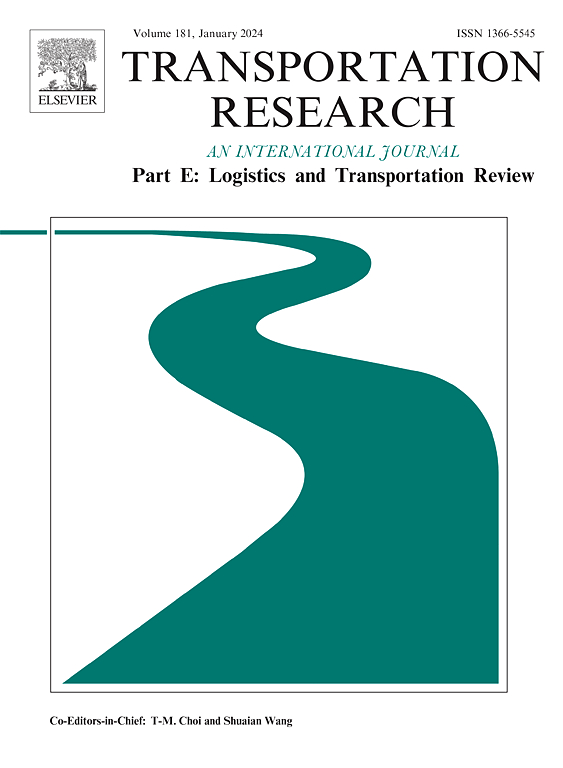Optimal carbon–neutral strategies in the healthcare system: A three-stage Stackelberg game model
IF 8.3
1区 工程技术
Q1 ECONOMICS
Transportation Research Part E-Logistics and Transportation Review
Pub Date : 2025-04-22
DOI:10.1016/j.tre.2025.104128
引用次数: 0
Abstract
The healthcare sector is a major contributor to global carbon emissions, accounting for approximately 4%–5% of greenhouse gases. Despite growing concerns about environmental impacts, existing research largely isolates carbon reduction strategies specific to certain medical processes or supply chain components, neglecting the integrated nature of decision-making among key healthcare stakeholders. This paper bridges this gap by developing a comprehensive decision framework for optimal carbon–neutral strategies within a four-tier healthcare system comprising the government, non-profit hospitals, for-profit hospitals, and patients. Government carbon policies significantly influence hospital investments in carbon–neutral operations, which subsequently affect patient choices based on pricing and service quality. To optimize this process, a three-stage Stackelberg game model is formulated that captures the hierarchical and interdependent decision-making processes characteristic of healthcare operations. An incorporated algorithm consisting of four sub-algorithms is proposed, combining two methods: (1) discretization of medical service pricing and quality on hospital-level operations, and (2) a grey wolf optimizer-based heuristic method to determine optimal government policies regarding carbon tax, emission reduction subsidies, and carbon absorption subsidies. To verify the model and validate the algorithm, numerical experiments are conducted using data from a non-profit hospital in Canada and a for-profit hospital in the UK. This study introduces a novel, multi-tier decision model that links carbon policy governance with hospital operational decisions and patient behavior. The results provide practical insights for policymakers and hospital administrators, laying the groundwork for future empirical studies in sustainable healthcare management.
医疗保健系统中最优碳中和策略:一个三阶段Stackelberg博弈模型
医疗保健行业是全球碳排放的主要来源,约占温室气体的4%-5%。尽管对环境影响的关注日益增加,但现有的研究在很大程度上孤立了特定于某些医疗过程或供应链组件的碳减排策略,忽视了关键医疗利益相关者之间决策的综合性质。本文通过在由政府、非营利性医院、营利性医院和患者组成的四级医疗保健系统中制定最佳碳中和战略的综合决策框架,弥合了这一差距。政府的碳政策显著影响医院对碳中和业务的投资,进而影响患者基于定价和服务质量的选择。为了优化这一过程,制定了一个三阶段Stackelberg博弈模型,该模型捕捉了医疗保健操作的分层和相互依存的决策过程特征。提出了一种包含4个子算法的合并算法,结合两种方法:(1)医院层面的医疗服务定价和质量离散化;(2)基于灰狼优化器的启发式方法确定碳税、减排补贴和碳吸收补贴的最优政府政策。为了验证模型和验证算法,使用加拿大一家非营利性医院和英国一家营利性医院的数据进行了数值实验。本研究引入了一种新颖的多层决策模型,将碳政策治理与医院运营决策和患者行为联系起来。研究结果为政策制定者和医院管理者提供了实践见解,为未来可持续医疗管理的实证研究奠定了基础。
本文章由计算机程序翻译,如有差异,请以英文原文为准。
求助全文
约1分钟内获得全文
求助全文
来源期刊
CiteScore
16.20
自引率
16.00%
发文量
285
审稿时长
62 days
期刊介绍:
Transportation Research Part E: Logistics and Transportation Review is a reputable journal that publishes high-quality articles covering a wide range of topics in the field of logistics and transportation research. The journal welcomes submissions on various subjects, including transport economics, transport infrastructure and investment appraisal, evaluation of public policies related to transportation, empirical and analytical studies of logistics management practices and performance, logistics and operations models, and logistics and supply chain management.
Part E aims to provide informative and well-researched articles that contribute to the understanding and advancement of the field. The content of the journal is complementary to other prestigious journals in transportation research, such as Transportation Research Part A: Policy and Practice, Part B: Methodological, Part C: Emerging Technologies, Part D: Transport and Environment, and Part F: Traffic Psychology and Behaviour. Together, these journals form a comprehensive and cohesive reference for current research in transportation science.

 求助内容:
求助内容: 应助结果提醒方式:
应助结果提醒方式:


